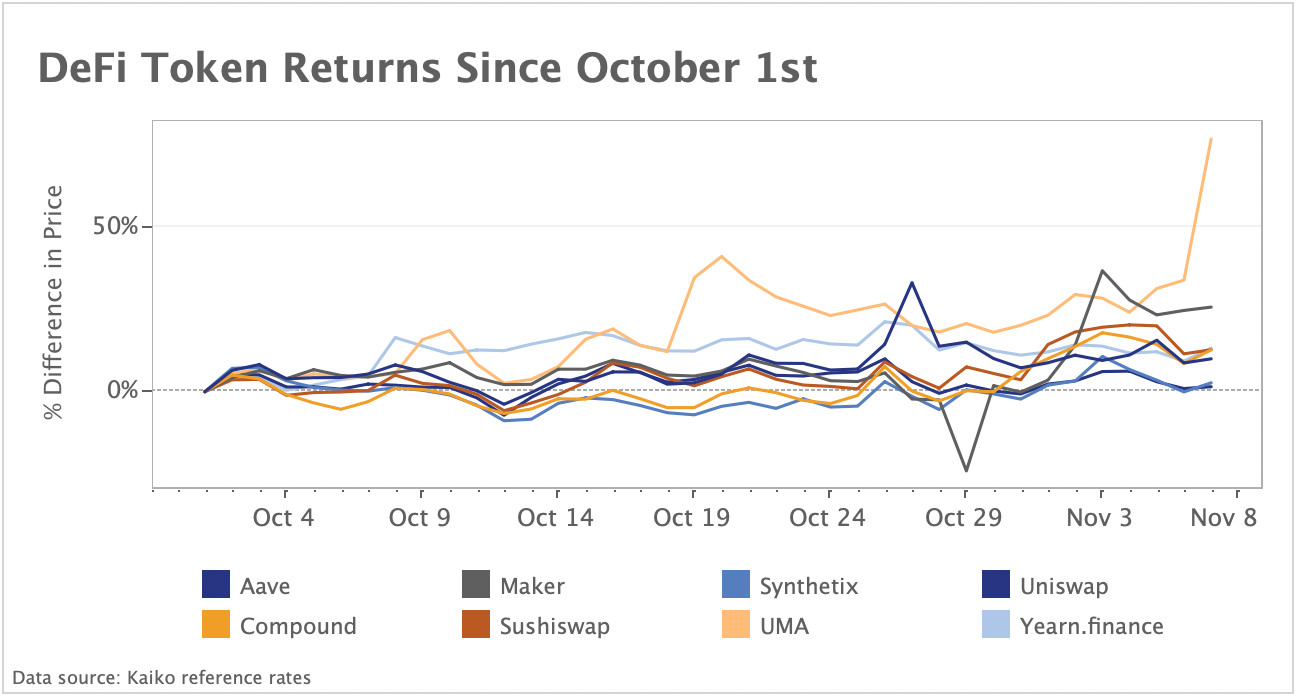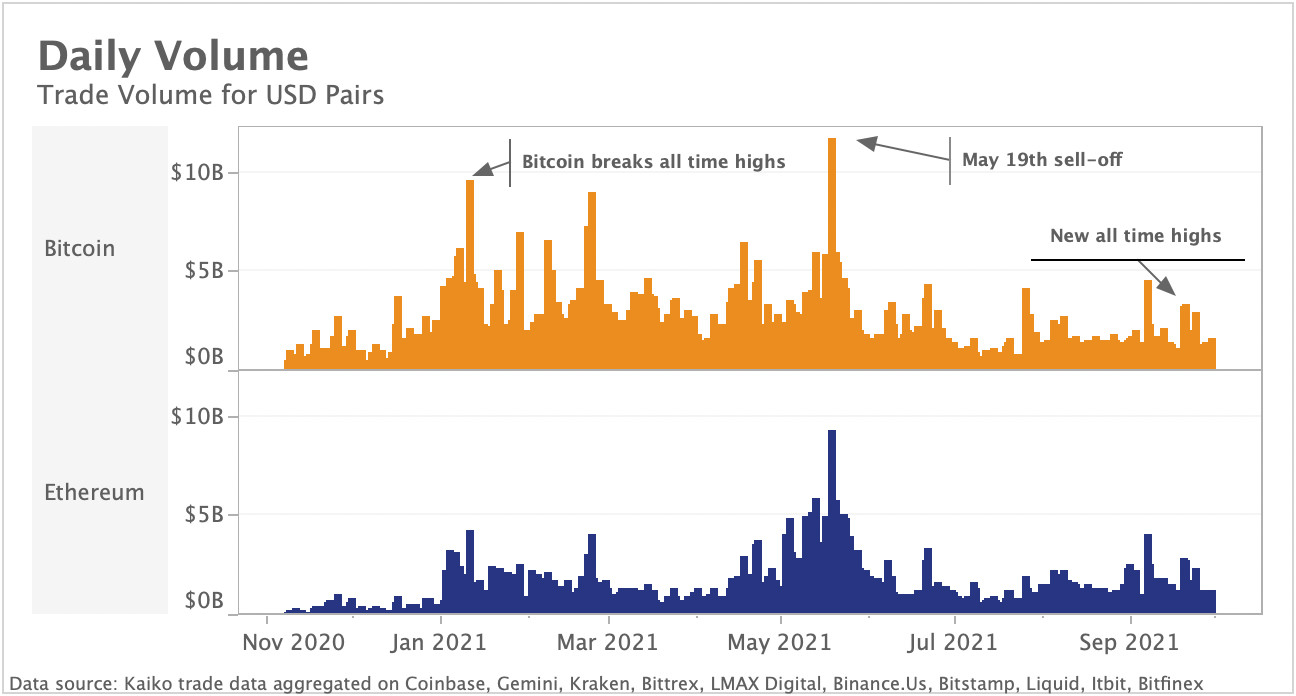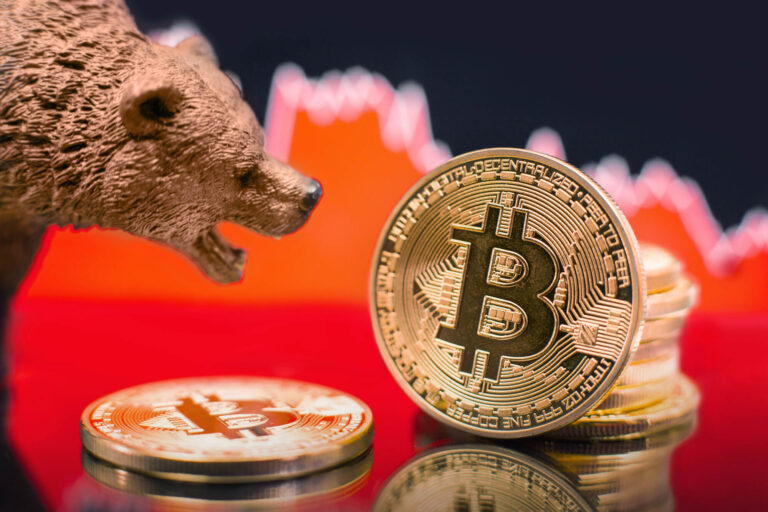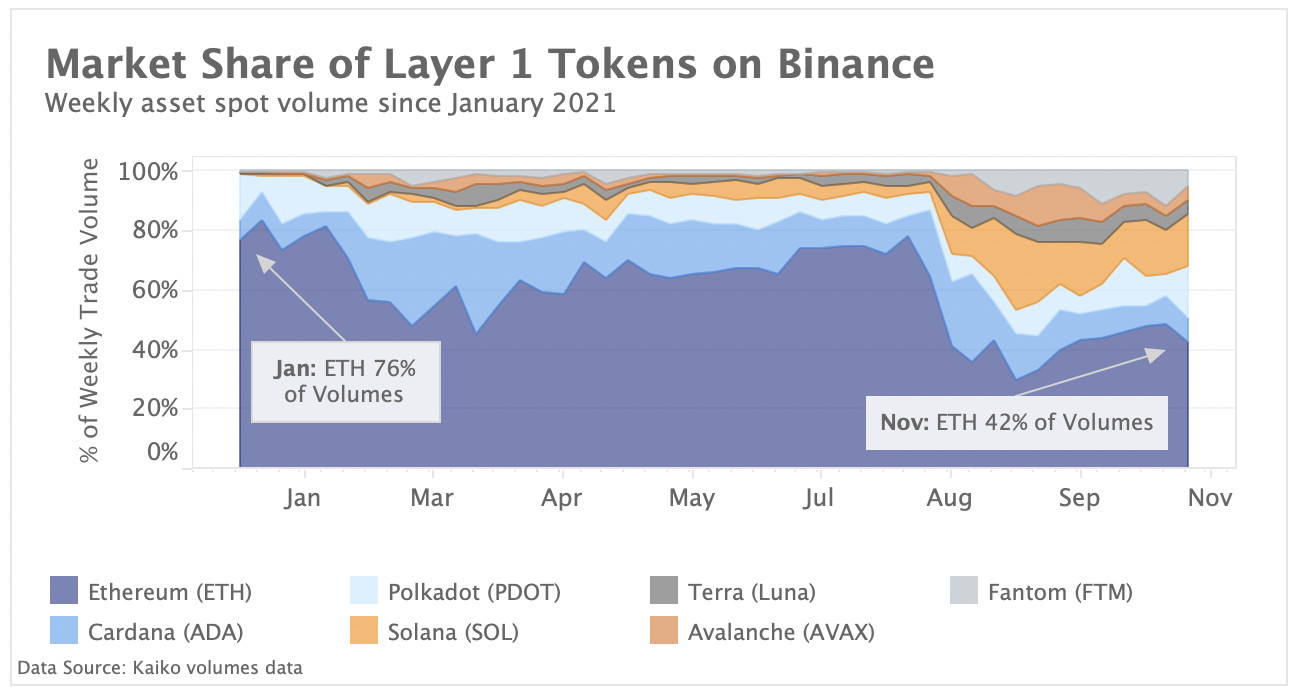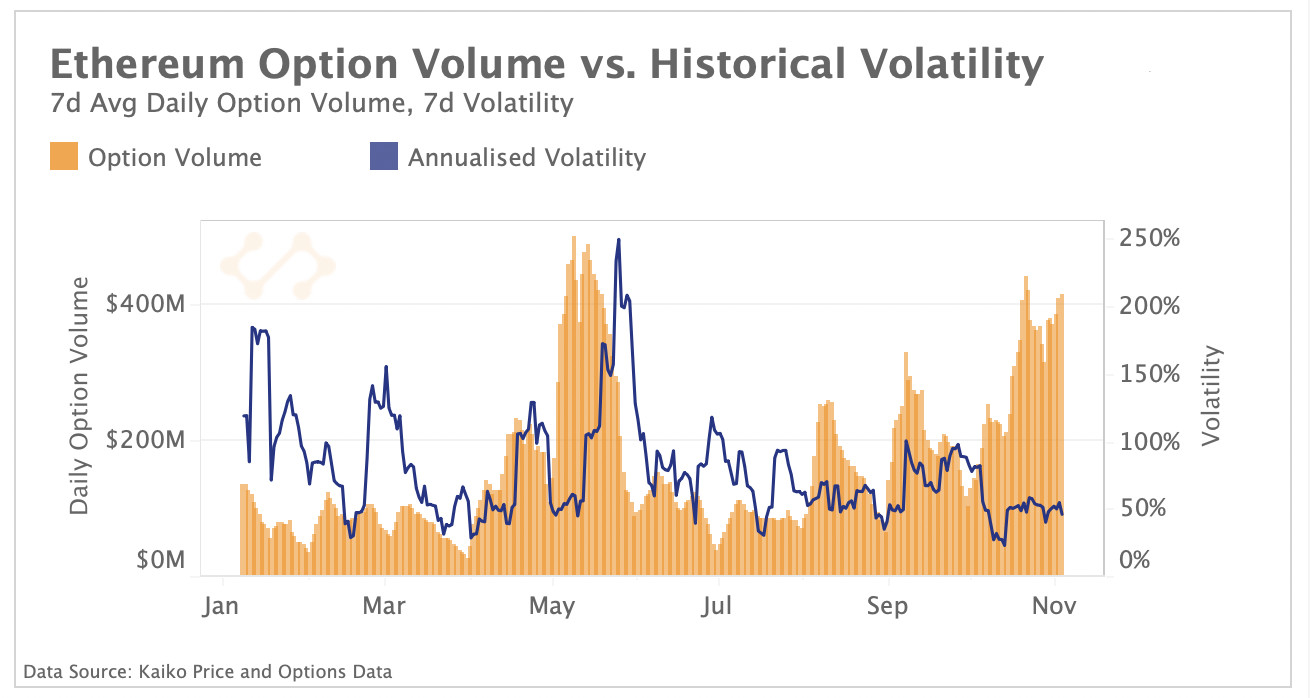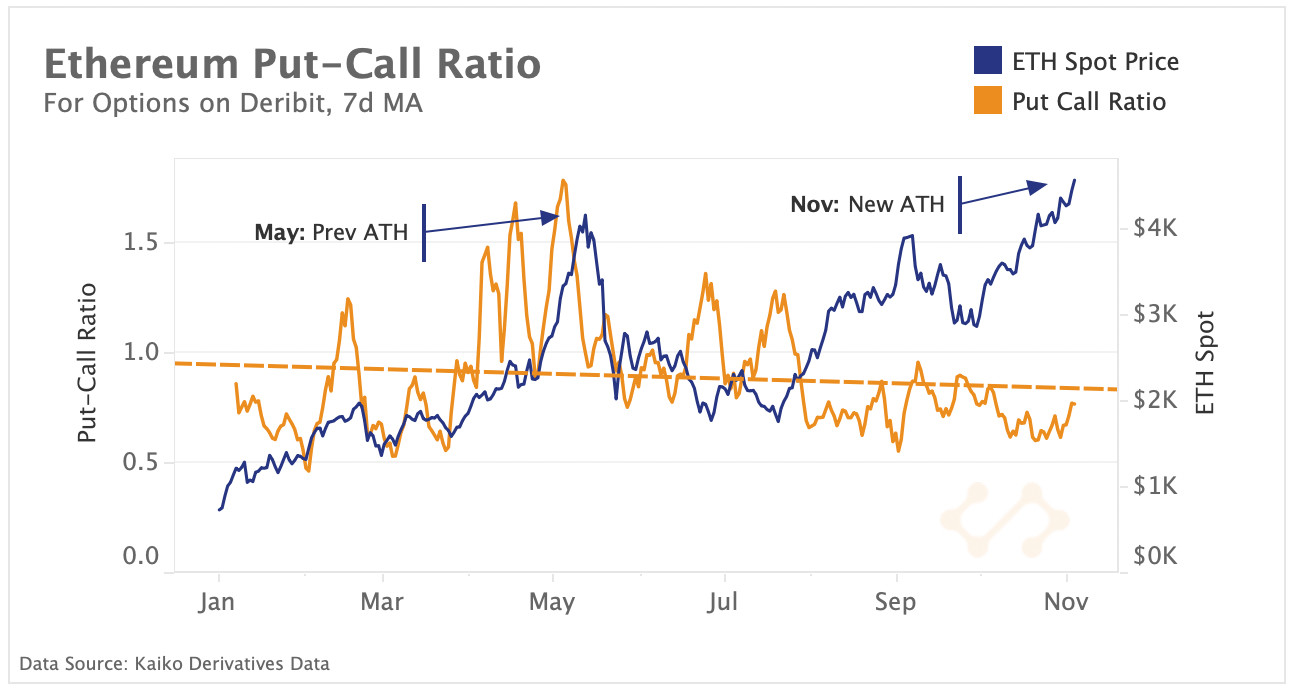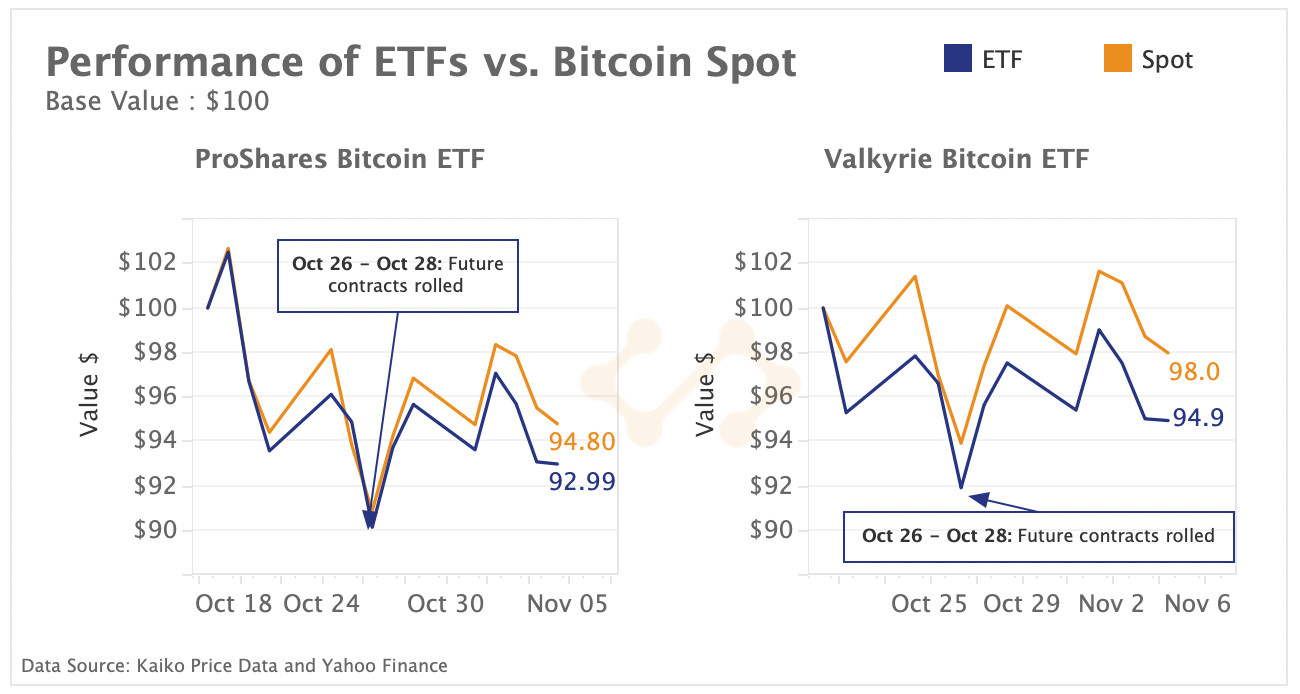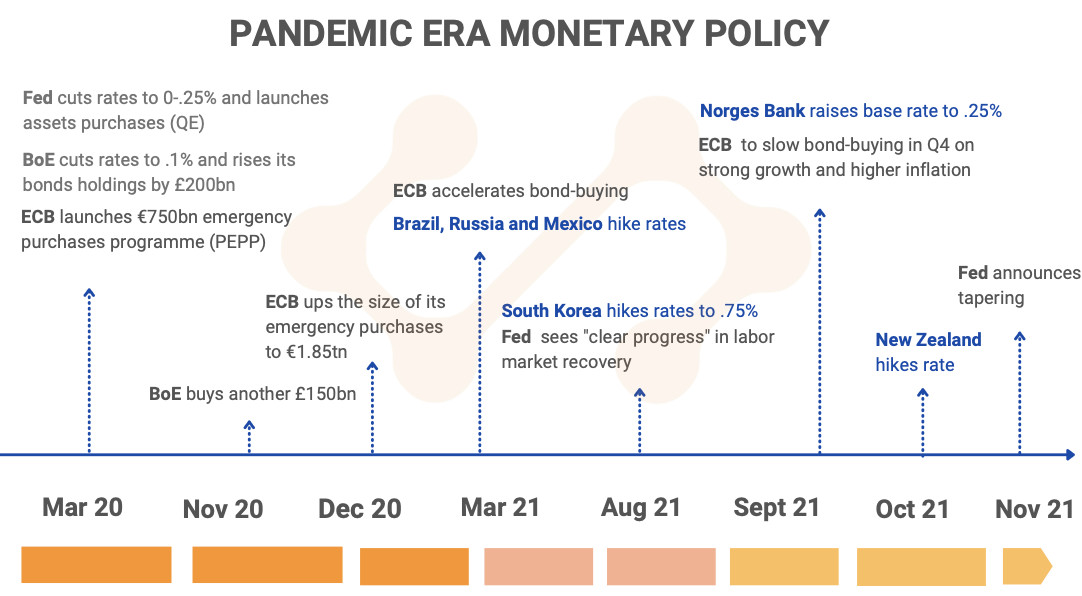A summarizing review of what has been happening at the crypto markets of the past week. A look at trending sectors, liquidity, volatility, spreads and more. The weekly report in cooperation with market data provider Kaiko.
The last 7 days in cryptocurrency markets:
- Price Movements: Ethereum again broke all time highs along with several of its Layer 1 competitors.
- Volume Dynamics: Despite a market-wide bull run, trade volume lags previous highs set in May.
- Order Book Liquidity: Market depth for Bitcoin and Ethereum has fallen steadily since March 2020, as measured in native units.
- Derivatives: Rising Ethereum options volumes and a falling Put-Call ratio suggests trader confidence.
- Macro Trends: The two futures-based Bitcoin ETFs have underperformed Bitcoin spot since they launched.
Ethereum continues to soar

Early Monday morning, Ethereum again broke new all time highs above $4,750 as the network came off of its first ever deflationary week, which saw more ETH burned than created. On-chain network activity is near record highs in large part due to a rise in NFT-affiliated transactions, despite continued concerns around scalability and high transaction fees. Several of Ethereum's Layer 1 competitors - including Solana, Polkadot, and Avalanche - also had a stellar week filled with new all time highs and ecosystem growth funds. Bitcoin held steady above $60k and showed little signs of stress following the Fed's confirmation that tapering would begin later this month.
In other crypto news, Digital Currency Group closed a $700m round led by Softbank, NYC's new mayor-elect wants his first three salaries paid in Bitcoin, and the Biden administration released a framework for regulating stablecoins.
DeFi markets are underperforming
Overall, DeFi token returns remain positive since October 1st, but pale in comparison to the massive returns recently experienced by Layer 1 and NFT-affiliated tokens. Ethereum is up more than 40% since the start of October, while the majority of DeFi tokens are up less than half. Decentralized exchange Uniswap’s governance token UNI is the worst performer with a meagre +1.5% while its rival Sushiswap (SUSHI) is up 12.7%. UMA and Maker registered the strongest growth of 76% and 26%, respectively.
The relatively lackluster returns comes as the industry struggles with a series of high-profile hacks and rising Ethereum transaction fees. Last week, DeFi Lender bZx suffered a hack of $55mn and the week before, Cream Finance was hacked for more than $130mn.
Despite record highs, trading volume lags
Both Bitcoin and Ethereum have broken all time highs over the past few weeks, but daily trade volume has remained relatively flat since the summer. Bitcoin trade volume today is about half its average from January to May. Ethereum volume has fared better, recently returning to just below January levels, although it sharply lags May volumes. One thing to point out is that May's record high volume was a result of all time highs followed by a massive price crash. Let's hope a price crash is not all that's needed to boost today's lagging volumes, because it seems that today's all time highs are not enough to draw in the amount of new investors we saw earlier this year.
Ethereum is losing market share to other Layer 1s
To analyse how investors are reacting to the rise of alternate Layer 1 protocols, we chart their market share relative to Ethereum on Binance, the world's largest exchange. Since January, Ethereum's market share relative to top Layer 1 tokens has fallen from 76% to 42% of total volume. Among the “Ethereum Killers”, Solana has grabbed a lion's share of volume as the blockchain is increasingly used for NFT and DeFi transactions, with secondary sales of NFTs on the network recently surpassing the $0.5 Billion mark. The recent NFT fervour has again generated high transaction fees on the Ethereum blockchain, making alternate networks that solve for scalability concerns more attractive.
Ethereum option markets see highest volumes since May
Coinciding with Ethereum setting new price records, options trade volumes have surged on Deribit, the largest crypto options exchange. We chart the 7 day moving average of Ethereum option volumes on Deribit along with its 7 day price volatility. Option volumes generally increase when markets turn volatile and traders take directional bets as buyers of options have a potential to earn high gains while keeping their losses limited (due to a non-linear option payoff). However, despite low-levels of volatility, option volumes recently hit their highest level since May.
To analyse this trend, it is necessary to delve deeper into the composition of option volumes. Below, we chart the put-call ratio calculated by taking the ratio of the traded volume for puts vs. calls.
Traders buy call options to bet on price increases and seek protection via puts if they foresee price declines. For example, a put-call ratio of 0.7 indicates that put volumes are 0.7 times call volumes. A rising ratio is viewed as bearish since it suggests that traders are purchasing more puts (bearish bets) than calls (bullish bets).
The ratio hit a yearly high in May as traders increasingly sought downside protection to compensate for the elevated bouts of market volatility. Since mid-September, the ratio has been on a downward trend, which suggests traders are more confident in the current market and are seeking less protection.
Bitcoin ETFs roll their futures allocations for the first time
Last month, crypto markets achieved a major milestone with the launch of the first futures-based Bitcoin Exchange Traded Funds (ETFs) in the United States. While these ETFs are attractive for investors wanting to gain exposure to Bitcoin via their traditional brokerage accounts without worrying about custody, they might not be the most efficient investment vehicle. Both ProShares and Valkyrie ETFs build synthetic exposure to Bitcoin via futures and need to roll their exposure into longer term contracts as the front end contracts expire.
Both ETFs rolled their exposures for the first time on Oct 26 - Oct 28. Above, we compare the performance of an initial investment of $100 in Bitcoin futures-backed ETFs versus a direct Bitcoin investment. Currently, futures prices are higher than spot (which is referred to as “contango”), so the funds had to roll into “the more expensive” long term contracts which drags their performance lower. We observe that the ProShares Bitcoin ETF tracks the underlying price movements better than the Valkyrie ETF despite both ETFs underperforming the Bitcoin spot market by 1.9% and 3.1% respectively.
U.S. equities hit record highs after Fed announces tapering
As expected, the U.S. Fed announced last week it will start reducing its $120bn monthly asset purchases this month, with plans to end the program by mid-2022. Markets appear to have already priced in the Fed’s hawkish pivot, with major stocks breaking fresh records on strong Q3 earnings immediately following the announcement. Bitcoin was mixed in trading, fluctuating between $61K and $62K on Nov 3.
Since March 2020, the U.S. central bank has added over $4tn to its balance sheet (charted above) which currently nears $9tn or over 40% of the U.S. nominal GDP. The broad-based S&P 500 gained over 43% since the start of 2020 while the tech-heavy Nasdaq 100 rose by 82%. Bitcoin also rallied from $7K to $63K as smart money flowed into crypto markets.
Extraordinary monetary policy stimulus since the start of the pandemic has boosted global market liquidity, leading investors to climb higher up the risk curve in search of returns. As liquidity injections cool down and markets stand on their own, analysts expect a slowdown in equities and risk assets growth. Below, we chart major monetary policy enacted by global central banks since March 2020.
Central banks around the world face a complicated choice between balancing inflation risks and economic growth, as raising interest rates too quickly could strangle the recovery. Despite reducing its monthly purchases, the U.S. Fed has signaled that it will prioritize full employment over the risk of higher prices and is not in a hurry to raise interest rates. However, several countries have been forced to hike rates over the past few months (infographic above).


